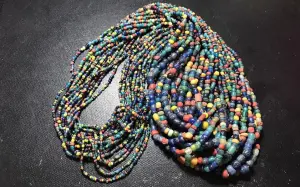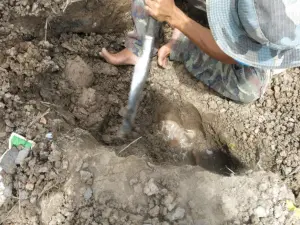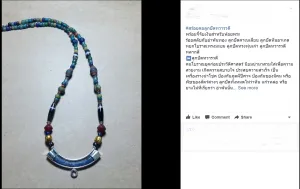Phacharaphorn Phanomvan digs into cross-border antiquities-smuggling practices.
Ancient jewellery, coins, and tiny ornaments for the mantelpiece may seem harmless when compared to a large bust or stolen sculpture, but the cumulative process to seek, loot, and put these materials on the market for consumers is much more destructive towards heritage than we often perceive. Many sites across Southeast Asia are lined with holes that tell tales of looting, shared overnight when tourists gather in pubs and restaurants. As tourists and collectors laugh and display the trinkets they purchase off ‘a child in the village’, a darker shadow lurks over heritage protection. While Bagan is showing signs of this problem, one of the most refreshing sights when visiting early historical sites in Myanmar is the absence of widespread looting activities. When I last visited Thayekhittaya (Sri Ksetra), Bago, and several newly discovered urban sites in Mon state, I was always amazed by the extent to which communities were involved with protecting the sites. Local authorities informed me that there was some ‘organised’ looting by certain groups hunting for gold and treasures, but villagers tended to leave the sites alone.
Myanmar is not exactly free of looting problems, but most of the time, only high profile cases receive media attention. Antiquities looting in modern Myanmar dates back to its colonial past, with many Buddha sculptures, coins, relics, and manuscripts ending up in Britain and Europe. Myanmar is a member of the 1970 Convention on the Means of Prohibiting and Preventing Illicit Import, Export, and Transfer of Ownership of Cultural Property but many of the country’s antiquities still end up in high-profile auction houses, just like other Southeast Asian antiquities. National attention to research, preservation, and conservation is often diverted towards religious artefacts and sites associated with Bamar history, which highlights the centrality of Burmese-speaking people and statecraft as a main driver of national historiography. This highlights the narrative of Tirkuls or Pyu states, as well as Bagan and subsequent kingdoms. Selective protection of a particular heritage over a more inclusive approach leaves a large part of the country’s diverse archaeological heritage and artefacts in places such as Shan, Mon, Karen, Rakhine vulnerable to looting and trafficking.


While looting of bigger antiquities such as sculptures and inscriptions receives media attention, cumulative smaller scale looting is much more virulent and destructive in the long run. Local archaeologists in Thailand estimate that extensive small-scale lootings can destroy up to 80% of the archaeological and historical context. There is also the risk of destroying ancient structures that could be conserved for future heritage projects. Many ancient temple sites looted between the 1960s and 1970s in the Khorat Plateau (in Northeastern Thailand) collapsed and were dismantled by locals for construction materials. The looting of beads is highly destructive, since the process often involves random testing of sites by digging different pits across large areas. Looting in this manner is highly destructive to historical landscapes, and can at times be dangerous for looters. The best time to find treasures is often during the rain or immediately after the rain. During the monsoon season, when heavy rains cause beads to surface, looting activity is at its highest. Looters, like miners, dig ‘L’ shaped pits to search for small artefacts along a certain depth. Looters would target areas near archaeological infrastructures that are poorly guarded, open agricultural fields where Iron Age burials can be found, and forest areas underneath trees (sometimes bamboo trees). Digging in these areas and at these times is dangerous, as both rain and tree coverage increase the risks of the ground collapsing on top of the digging looters.
Small-scale looters look for materials such as beads, metal jewellery, coins, and small religious amulets. They throw away materials such as iron and bronze tools, bones, and pottery. Beads in Southeast Asian sites are often related to late prehistoric to early historical sites. Indo-pacific beads are sold in “bucket fulls” across different local markets as well as in more prominent locations in Bangkok. Beads from Myanmar are increasingly becoming very popular on social media retail sites. Most Thai buyers seem to source primarily from Dawei and Tanintharyi. There is a strong preference for beads that ‘match’ those found in Thailand since they are easier to ‘authenticate’. On the other hand, there is a slow but growing demand among Chinese buyers for particular types of beads only found in Myanmar.

Looting networks, particularly those operating online through social media and web blogs, are very knowledgeable. They carefully monitor the academic community for references to help authenticate materials and potential new looting sites. There are also discussions on how to ‘clean’ objects. In addition, it is not uncommon for looters to forge artefacts such as beads, coins, or larger materials. Conversely, they also establish online communities to identify forgeries and forging techniques.

Over the past six years, I have been following networks of small scale looters in Thailand in person, and have monitored its online activities. In the past, Buddha sculptures and artefacts from Myanmar have turned up along the Thai borders in Chiang Rai, Tak, and Prachuabkirikhan. Until recently, they were only of interest to a very niche group, and were not valued as highly as Thai or Cambodian antiquities in the market. However, with the recent growing interest in Myanmar and the simultaneous clamp-down on dealings in Thai and Cambodian antiquities, materials from Myanmar are left susceptible to the black market. Whether the artefacts crossing the borders are genuine or not is a matter for the buyer’s knowledge, but smaller scale goods such as beads and coins are increasingly appearing in Bangkok’s flea markets and online retail communities.

“Subsistence looting/digging”, the act of looting to supplement a meagre income, has been put forward as a reason to explain extensive looting in Southeast Asia. My experience of talking to looters I encountered on both sides of the border have revealed multiple socio-economic backgrounds.
In remote areas with little education and limited market access, beads and materials found in agricultural fields are sold at subsistence level. Looters from this group are usually more literate local labourers, teenagers and children. Older generations in these communities often refrain from looting due to their spiritual beliefs. Goods in this area are either purchased by a monopoly of buyers or tourists looking for materials. Many remote areas in Myanmar are still susceptible to subsistence looting problems.
The second group of looters can be described as a ‘regional network of collectors’. Looters collect artefacts and loot by renting or monopolising access to multiple sites. They have an elaborate system for exchanging information on price and authenticity. Online social media platforms have empowered this group of collectors, and have eased market access for new entrants with sufficient knowledge and money. One of the most well-informed groups covers the area that stretches from Krabi Province in Thailand (Khlong Thom) to Surat Thani and across the border to Dawei and up to Tanintharyi. They are usually willing to exchange limited information with academics and archaeologists.
The third group loots to fill seasonal unemployment. People in this group are often fishermen and agricultural labourers. Some are lucky enough to live in ancient settlements and will use their housing area or agricultural field as looting grounds. Others rent looting locations from land owners at day rates or pit rates, depending on the site’s popularity. From my observations of this particular group’s activity on social media, the increasing amount of professional networking between labourers in Thailand and Myanmar, particularly in the agricultural and fishery sectors, has led to a growing number of ‘backyard looting’ trips to Myanmar.
Ancient beads and coins are not mere trinkets for collectors, but often hold a special spiritual value. Most collectors believe that beads from ancient sites contain special powers that will bring them fortune and protection. This is particularly tied to religious narratives, such as affiliation with sites known as ancient trade emporia or sites thought to have a close relationship to the arrival of Buddhism and Hinduism in Southeast Asia. Objects that are tied to locations with religious history and people from ‘blessed’ locations and time periods are viewed by collectors as highly valued magical charms. Examples include areas around Mon State and the Isthmian Peninsula, where the semi-mythical country of ‘Suvarnabhumi’ received Asoka’s Buddhist missionaries. Artefacts associated with this period come from Iron Age and early historical sites in Thailand and Myanmar. Collectors are not only acquiring beads as works of art, but also physical links to people who lived during a religiously significant period in time. A sense of reverence over the ‘glorious past’ exists among local collectors, who believe that people in the past possessed great spiritual powers and enchantment abilities which were transferred onto objects.
Moreover, ownership of beads such as Pumtek (elongated salicized etched bead), for example, displays wealth and position within Chin communities. This idea has been adopted by bead collectors, who advertise the spiritual and magical aspects of the artefacts. A collector with large and rare beads is considered to have a high level of ‘soul stuff’ (an animist concept of supernatural prowess), which is mixed with the Theravada Buddhist idea of exhibiting barami (Pali: Parami for ‘characteristic perfections’. People with more barami are believed to be closer to attaining enlightenment). Antique procurement is also a material display and measurement of the individual’s punna or merit, which locals believe is reflected through the number of rare and precious items an individual possesses. It is interesting that beads from Myanmar are perceived to be more genuine and highly imbued with extra power because of Myanmar’s close affinity to Buddhism.

The primary concern is that, with growing trade and interactions, small-scale looting can become a serious problem for undiscovered heritage in Myanmar. While Thailand has a comprehensive database of archaeological sites across the country, a large part of Myanmar has yet to be surveyed and monitored. Even with extensive recording on the Thai side, the destruction of archaeological sites, notably of Iron Age and early historical settlements, has been detrimental.
The race to protect heritage is also a battle against poverty. Sites like Mrauk-U in Arakan State have been highlighted by Global Heritage Fund as highly endangered areas. While international organisations and some academics are now diverting efforts towards recording, monitoring, and empowering local initiatives to combat growing destruction of heritage, efforts and fundings are not sufficient for the amount of heritage within the country and primarily concentrate on the main UNESCO sites like Bagan and Pyu cities. This leaves peripheral and border areas extremely vulnerable to looting, particularly those areas that are undergoing rapid modern development near Thailand. Little attention has been placed on the smuggling of small artefacts and beads, which is often viewed by authorities as ‘petty crime’. In reality, illicit trade in artefacts across borders is usually part of larger archaeomafia networks that also smuggle drugs and weapons. Subsistence looters are not benefitting from sales of small artefacts since they often sell to intermediaries that retail materials at higher prices. Studies have shown that subsistence looting is neither an “equitable enterprise, nor is it a long-term solution to economic deprivation”.
A heavy burden is placed upon governments of emerging economies to police looters and track down lost artefacts. These efforts would be better diverted towards addressing the demand side of the market, like sellers and collectors. At the same time, archaeologists should strive to develop an engagement approach with local communities and use heritage sites, even smaller ones, to develop alternative income and incentives. An increasing amount of grant funding for excavations now contains preferences for projects that can help develop local communities such as the Archaeological Institute of America (AIA) funding for initiatives in Latin America and Cambodia. The Myanmar Archaeological Association (MMA) has started working with communities in Bagan and Pyu sites to encourage public awareness and develop local cultural management organisations for planning and resisting looting among villagers. These local efforts will need more funding and capacity building to expand towards sites outside Burman historical attention.
Most archaeologists agree that urban development, agricultural practice, and looting have extensively destroyed Thailand’s archaeological heritage. I write this in the hope that some efforts could be diverted towards containing ‘trinket’ collection trends among the growing middle class that have led to a very widespread and destructive small-scale looting practice. However, in the long term, it is necessary to develop a further understanding of the effectiveness of law enforcement on small-scale looting. To minimise looting, communities need to be offered better alternative careers that can potentially involve heritage development.
Phacharaphorn Phanomvan is a D.Phil Candidate in Economic History at the University of Oxford. Her research is about ancient growth and trade in Myanmar and Southeast Asia. She is broadly interested in the roles of geography, technology, institutions, and heritage in long run growth and development.
Like This Article
April 26, 2023
April 03, 2023
September 08, 2021
December 07, 2020

Center for Southeast Asian Studies, Asian Institute 1 Devonshire Place Toronto, Ontario, M5S 3K7, Canada
©TeaCircle All Rights Reserved 2023